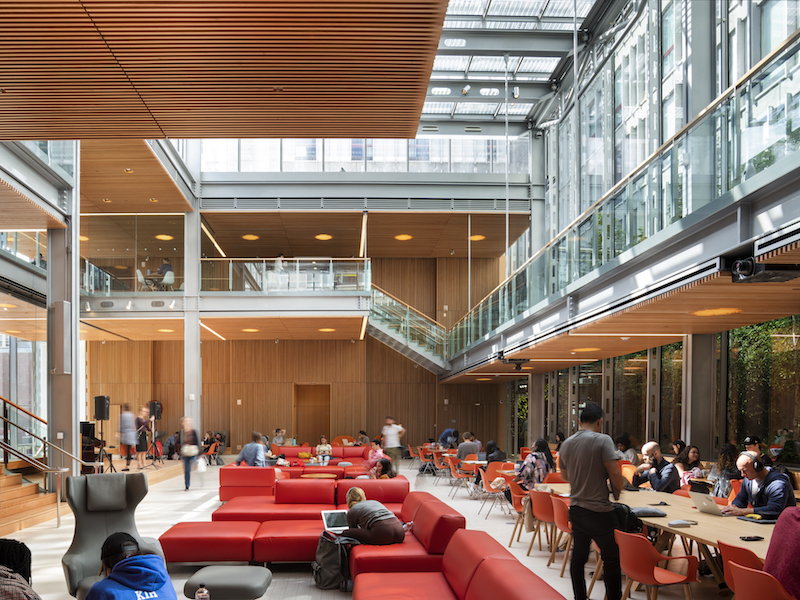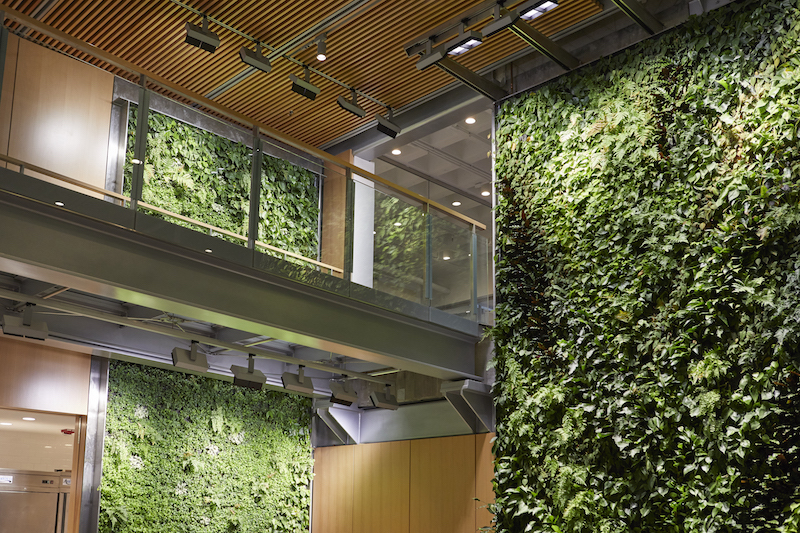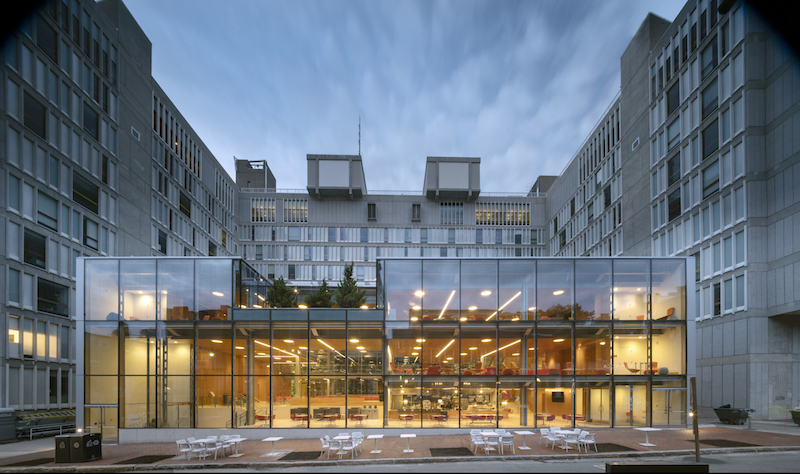In early March, the 80-seat Heights Restaurant & Bar opened on the 10th floor of the Smith Campus Center at Harvard University, in the heart of Harvard Square in Cambridge, Mass. This is the latest addition to a “common spaces” initiative that Harvard’s former President Drew Faust launched in 2008 to create a singular area on campus where thousands of faculty, students, staff, and visitors can congregate.
Harvard now boasts 385,000 sf of dedicated community space within the H-shaped Richard A. and Susan F. Smith Campus Center. The public can access the first floor and most of the second floor of the Center, which along with the 10th floor underwent a 36-month reconstruction and renovation that was completed last September, and entailed the excavation of 975 tons of demolition debris.
This project’s community and user outreach was extensive, with 25 focus groups and a survey that received 600 responses. The University also conducted a furniture showcase in the fall of 2016, around the same time that construction began.
 Harvard University's “One Harvard” concept creates a gathering place for students, faculty, staff, and the community. Image: Courtesy of Consigli Construction
Harvard University's “One Harvard” concept creates a gathering place for students, faculty, staff, and the community. Image: Courtesy of Consigli Construction
These efforts helped inform the redesigns by Hopkins Architects. (Bruner/Cott & Associates was the executive architect.) Consigli Construction executed the complete gutting of the 10th floor, and selective remodeling on the two lower floors that include the Moise Y. Safra Welcome Pavilion and Plaza, says Todd McCabe, Consigli’s Vice President-Project Services, who with John Lehane, the firm’s Project Manager, spoke with BD+C last week.
The renovation recreated the building’s Arcade (where most of the restaurants are) from a dungeon-like “two stories of concrete,” says Lehane, to a more inviting space with “more glass, new programming, and a large landscape area” with three or four green walls irrigated with UV-filtered rainwater. (Michael Van Valkenburgh Associates was the landscape architect.)
He says that one of this project’s biggest challenges was restoring the building’s façade and expanding the former Holyoke Center, which required the structural demolition of a two-story annex over a parking garage and then putting a three-story building in its place. The building’s “front door” is now highlighted by a two-story curtainwall. There’s also a three-story curtainwall on the Holyoke Street side of the building.

The remodeled building includes several green walls that are irrigated by UV-filtered rainwater. Image: Consigli Construction
Outside, new plazas open onto two thoroughfares.
Lehane notes that “what often gets overlooked” in projects like these is the MEP system. Working with engineer Arup, Consigli dedicated a MEP manager to “trace out” the system in order to keep it operable, as 500 people continued to work in the Center during the renovation, and thousands more walked through it every day. (The Center houses several of the university’s departments as well as Harvard University Health Services.)
All told, there were between 20 and 25 Building Team members on this project, says McCabe, including Consigli’s VDC team, which used virtual design tools for communications and planning, especially for occupied areas within the building.
Related Stories
Market Data | Aug 1, 2023
Nonresidential construction spending increases slightly in June
National nonresidential construction spending increased 0.1% in June, according to an Associated Builders and Contractors analysis of data published today by the U.S. Census Bureau. Spending is up 18% over the past 12 months. On a seasonally adjusted annualized basis, nonresidential spending totaled $1.07 trillion in June.
Market Data | Jul 24, 2023
Leading economists call for 2% increase in building construction spending in 2024
Following a 19.7% surge in spending for commercial, institutional, and industrial buildings in 2023, leading construction industry economists expect spending growth to come back to earth in 2024, according to the July 2023 AIA Consensus Construction Forecast Panel.
Mass Timber | Jul 11, 2023
5 solutions to acoustic issues in mass timber buildings
For all its advantages, mass timber also has a less-heralded quality: its acoustic challenges. Exposed wood ceilings and floors have led to issues with excessive noise. Mass timber experts offer practical solutions to the top five acoustic issues in mass timber buildings.
Adaptive Reuse | Jul 6, 2023
The responsibility of adapting historic university buildings
Shepley Bulfinch's David Whitehill, AIA, believes the adaptive reuse of historic university buildings is not a matter of sentimentality but of practicality, progress, and preservation.
University Buildings | Jun 26, 2023
Univ. of Calif. Riverside’s plant research facility enables year-round plant growth
The University of California, Riverside’s new plant research facility, a state-of-the-art greenhouse with best-in-class research and climate control technologies, recently held its grand opening. Construction of the two-story, 30,000 sf facility was completed in 2021. It then went through two years of preparation and testing.
University Buildings | Jun 26, 2023
Addition by subtraction: The value of open space on higher education campuses
Creating a meaningful academic and student life experience on university and college campuses does not always mean adding a new building. A new or resurrected campus quad, recreational fields, gardens, and other greenspaces can tie a campus together, writes Sean Rosebrugh, AIA, LEED AP, HMC Architects' Higher Education Practice Leader.
Standards | Jun 26, 2023
New Wi-Fi standard boosts indoor navigation, tracking accuracy in buildings
The recently released Wi-Fi standard, IEEE 802.11az enables more refined and accurate indoor location capabilities. As technology manufacturers incorporate the new standard in various devices, it will enable buildings, including malls, arenas, and stadiums, to provide new wayfinding and tracking features.
Laboratories | Jun 23, 2023
A New Jersey development represents the state’s largest-ever investment in life sciences and medical education
In New Brunswick, N.J., a life sciences development that’s now underway aims to bring together academics and researchers to work, learn, and experiment under one roof. HELIX Health + Life Science Exchange is an innovation district under development on a four-acre downtown site. At $731 million, HELIX, which will be built in three phases, represents New Jersey’s largest-ever investment in life sciences and medical education, according to a press statement.
Engineers | Jun 14, 2023
The high cost of low maintenance
Walter P Moore’s Javier Balma, PhD, PE, SE, and Webb Wright, PE, identify the primary causes of engineering failures, define proactive versus reactive maintenance, recognize the reasons for deferred maintenance, and identify the financial and safety risks related to deferred maintenance.
University Buildings | Jun 14, 2023
Calif. State University’s new ‘library-plus’ building bridges upper and lower campuses
A three-story “library-plus” building at California State University, East Bay (CSUEB) that ties together the upper and lower campuses was recently completed. The 100,977-sf facility, known as the Collaborative Opportunities for Research & Engagement (“CORE”) Building, is one of the busiest libraries in the CSU system. The previous library served 1.2 million visitors annually.

















